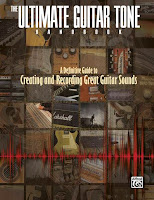Here's an excerpt from The Ultimate Guitar Tone Handbook
-----------------------------
A common recording process has an engineer EQing, compressing, and adding multiple mics in trying to capture a sound, yet never taking into account what the sound in the room at the source is like. That’s why it’s imperative that every engineer use the following steps in any serious microphone placement:
1. Go out into the room, stand in front of the amp or acoustic guitar player, and listen to them play the part from the song you’re about to record. Playing the song is important because you might be deceived if it’s another song or just random playing. Listen for the tonal balance from the amp or instrument as well as the way the room responds. Listening to the amp or acoustic guitar in the room will give you a reference point to the way it really sounds so you have a better idea of what you’re trying to capture.
2. Find the sweet spot. There are several ways to find the sweet spot.
- To place an omnidirectional mic, cover one ear and listen with the other. Move around the mic or player until you find the spot that sounds best. That’s where to place the mic to begin.
- To place a cardioid mic, cup your hand behind your ear (instead of covering it) and move around the player or amp until you find the place that sounds best.
- To place a stereo mic or stereo pair, cup both ears and move around the player or amp until you find the place that sounds best.
- As an alternate method, crank the amp until it’s noisy, then put on headphones and listen to the mic as you move it around until the noise has the best combination of highs and lows.
3. You can’t place the mic by sight. The best mic position must always be found, not predicted. It’s okay to have a starting place, but it’s usually never what ends up being the best spot.
4. Change the mic position instead of reaching for the EQ. Chances are that you can adjust the quality of the sound enough by simply moving the mic in order to avoid using any equalization. The EQ will add a least a small amount of phase shift at some frequency and can’t be undone later. Moving the mic (which amounts to an acoustic EQ) will usually sound smoother and more pleasing to the ear.
5. Give the mic some distance. Remember, distance creates depth. The guitar and amp will sound a lot more natural than using artificial ambience. If possible, leave just enough distance between the mic and the source to get a bit of room reflection to it.
6. Be careful miking multi-speaker cabinets. 4x12 cabinets like the typical Marshall 1960 pose a special challenge in that at a certain distance you have phase anomalies from the multiple speakers that you really don’t want to capture. The cabinet will sound fine when close miked from right against the grill cloth to approximately three inches away from the best sounding speaker in the cabinet, but until you get to a distance of 18 inches where the sound of all the speakers converge, you may be capturing some speaker interaction that’s not all that pleasant sounding. That distance varies with the make and model of speaker cabinet.
To read more about the book, go to The Ultimate Guitar Tone Handbook page on my website.
----------------------------------
Help support this blog. Any purchases made through our Amazon links help support this website with no cost to you.
You should follow me on Twitter for daily news and updates on production and the music business.
Don't forget to check out my Music 3.0 blog for tips and tricks on navigating the music business.



5 comments:
When you mention cardiod mics, do you mean cover one ear and then cup your hand behind the listening ear? The way you wrote it is somewhat unclear.
Yes, Matthew. That's what I meant to write.
Great! Thanks.
BTW... I love your books. I've read 3 of them cover to cover so far: The Mixing Engineer's Handbook, The Producer's Handbook, and Music 3.0. You have some great insights... keep them coming!
Soundproofing floors and floor soundproofing with the most effective slim line solutions on the market today.
Post a Comment